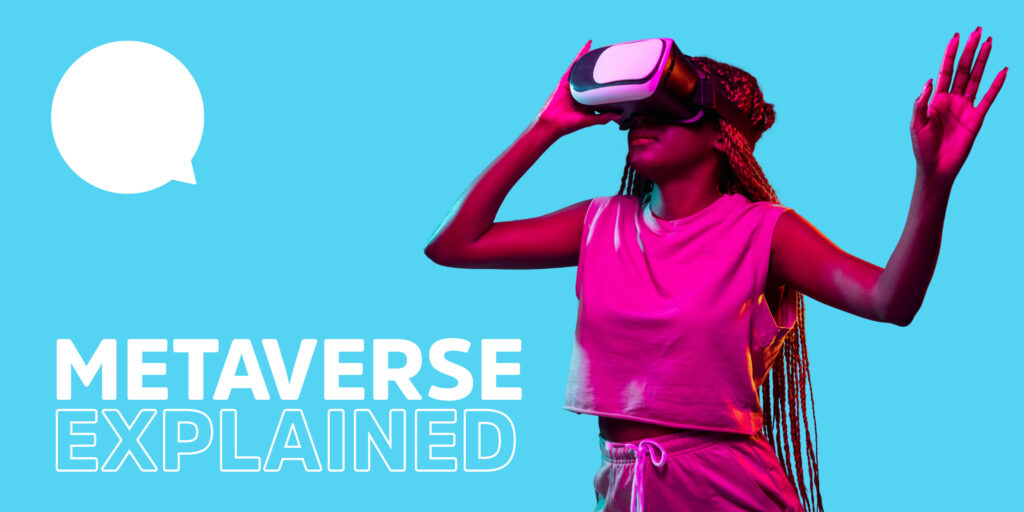The Metaverse: What is it and how will it change content marketing?
26th July 2022
Title: The Metaverse: What is it and how will it change content marketing
Cast your mind back to October 2021. You may recall Mark Zuckerberg announcing that his company is rebranding as Meta to signify its investment in the metaverse.
This announcement caused a 1567% spike in searches for the term ‘metaverse’ on Google. Now deep into 2022 the rise of the metaverse is drawing closer. Preparing for the unknown isn’t easy, but as digital pioneers we need to get ready and ask ourselves: Do we now know what the metaverse is? Do we know how it will impact our brands and content? Thanks to the HDY digital team, we’re quite clued up on the topic, and we’re here to share our knowledge with you and help you understand how the metaverse will impact content marketing.

Let’s start at the beginning. What is the metaverse?
To put it simply, the metaverse is a network of 3D virtual worlds focused on social connection. The vision is to build a blockchain technology environment that spans multiple devices, multiple realities and multiple channels of communication. This environment will allow anyone to interact, communicate, play games, work, attend concerts, watch films and lots more in virtual and augmented reality.
The virtual space will be accessible from more than just a computer screen. It will also span across technologies such as smart devices and wearable technology.
Understanding the metaverse can get a little confusing, especially when you’re not familiar with all the jargon that comes along with it. But we’ve found that the concept can be broken down into two parts that we are all a little more familiar with.
- Augmented Reality
Augmented reality (AR) refers to applying a digital layer to the real world. A market anticipated to become worth $340.16 billion by 2028 according to Grand View Research, this technology is a big deal.
AR can now be found everywhere including in filters, games and social commerce and will contribute to the metaverse significantly because of its accessibility and effectiveness. It is already a great tool to drive sales on mobile devices, allowing customers to try before they buy. Think for example of NYX, a high-street make-up brand, which allows you to try on lip colours via a filter. Or being able to try on different types of frames before you make an online purchase at Specsavers.
When it comes to the Metaverse, AR will allow for the creation of a digital overlay of the metaverse onto the real world, accessible for people wearing AR or ‘mixed-reality’ glasses. This overlay of the Metaverse onto the real world will allow the Metaverse to be seamlessly blended into daily life, as opposed to a VR world which needs to be consciously entered and exited.
- Virtual Reality
Virtual reality (VR), is the computer-generated simulation of a 3D image or environment that can be interacted with in a realistic or physical way through the use of special electronic equipment like headsets.
The implementation of VR has already begun and is already playing a massive part in the gaming industry, as well as training for the automotive and health industry.
VR is to be the main hub for the metaverse. Meta has already outlined plans for the majority of its services to be in the virtual world, with other experiences and devices linking in to provide an ever-present and always-on model. However, with the introduction of the metaverse, we can expect to see a lot more VR in social and work settings such as virtual hangouts, work meetings, and collaboration.
Virtual worlds will provide new ways of content marketing in the form of spatial ad placements and tangible experiences for consumers to experience products and services.
This opens up new avenues for creativity within the digital space, as engagement is going to be very key for brands moving into the metaverse era, leaving lasting impressions on audiences.
Now we get the gist of things, how can we expect the Metaverse to impact content marketing?
A new marketing channel
Channel marketing is a key part of content marketing. The metaverse is introducing a brand new marketing channel for brands to master, utilise, and implement into marketing strategies. Content marketing has already begun to experiment with immersive methods of exposure and engagement. Target audiences are shifting, and the metaverse is a new space for brands to amplify their voice.
According to Bloomberg Intelligence, the metaverse and its collective industries are projected to be worth $800 billion in the next two years. By moving into this new generation of marketing using AR and VR, brands will be able to reach and capitalise on new audiences before the industry begins to boom.
New ways of creating content and engagement
A new channel means new innovative ways of creating content and gaining user engagement. When TikTok became popular, along came a number of trends which gave creators new ways of creating content and increasing engagement. We can expect to see the same with the Metaverse.
Back in June 2020, British lifestyle brand Cath Kidston partnered with Nintendo to add clothing, home decor and furniture assets to the popular Animal Crossing game. Items had to be purchased with real money in the game for users to gain access. Through the inclusion of these assets, they drove brand awareness and purchase value through microtransactions. This is just one example of what the metaverse could introduce to the world of marketing.
Another opportunity lies with the sale of NFTs (Non-Fungible items), for example in the form of virtual clothing, housing items for your virtual home and user profile customisation. Imagine hopping into the Nike virtual environment on your VR headset and browsing for new clothes just as you would in real life. As soon as you make a purchase, it’s yours to use!
Measurement and analysis
Changing the way that we create and market content means the way we measure and analyse marketing will completely change.
We have already begun to see a shift in influencer marketing with brands as big as Samsung and Calvin Klein expanding their influencer marketing to include virtual influencers.
With the introduction of artificial intelligence (AI), and deep machine learning, virtual influencers will start to use semantics to be able to target audiences to influence and adapt to user behaviour. A semantic model within a Virtual Environment represents meaning and functionality which gives models greater flexibility of virtual objects.
The first step is to design a semantic model populated by digital items. After that, the main three aspects of development include;
- Interaction
- Visualisation
- Animation
Interacting with virtual environments, visualising in different contexts and animating the virtual characters all help to create an engaging environment that can be understood by both humans (users) and machines.
“The introduction of the Metaverse is going to shake up everything we currently know about user experience, channel marketing and brand exposure. Brands can innovate on conventional and frankly, boring methods of engagement and exposure, producing a high level of engagement and direct contact with their consumers in immersive environments. This unleashes so many possibilities for brands. However, we must be cautious. The industry is trying to gauge current and potential interest in the platform and we may see disinterest and distrust towards big tech companies such as Facebook.”
– Josh, HDY UX/UI Designer
It’s easy to acknowledge that times are changing. But in this field, it is important to stay ahead of the changes rather than simply keep up with them. At HDY we constantly have our eye on the ball and our knowledge can help you keep up with the latest content marketing trends and achieve amazing results.
Have a project you think we can help out with? Contact us.

